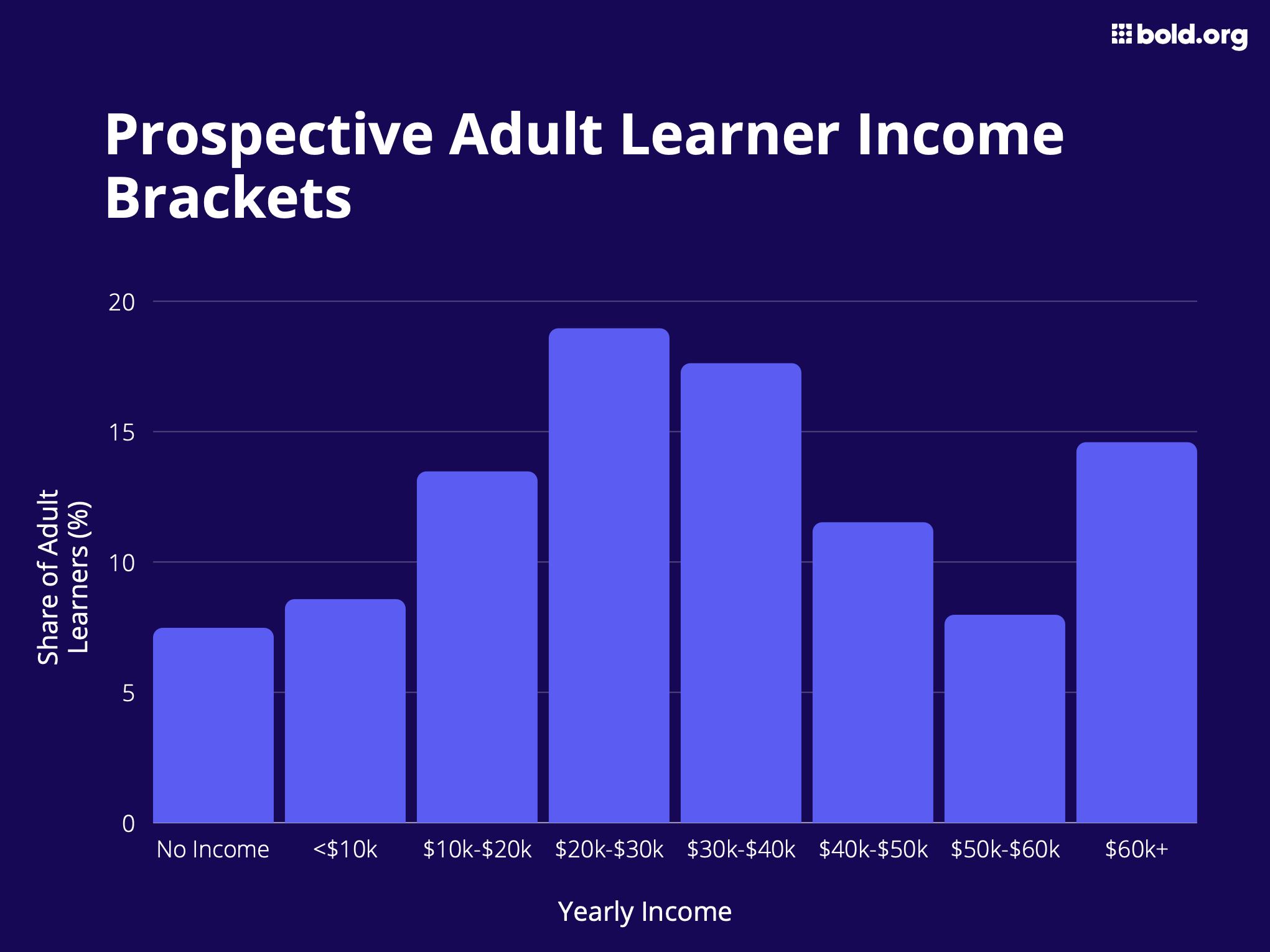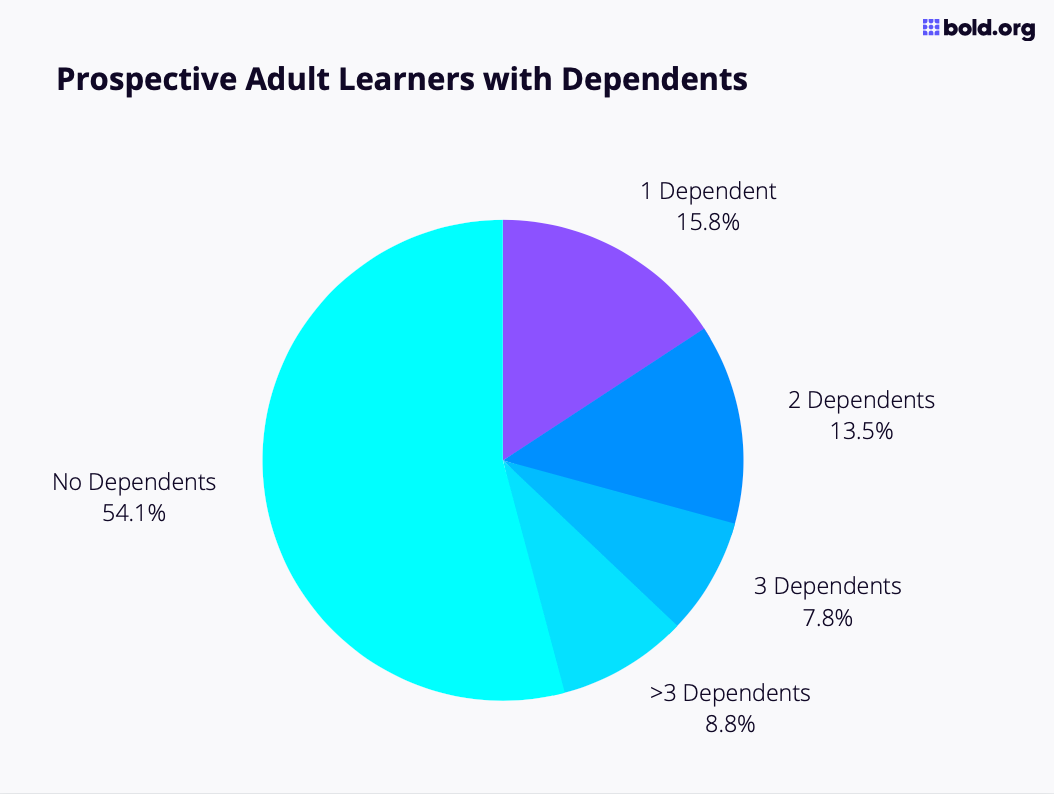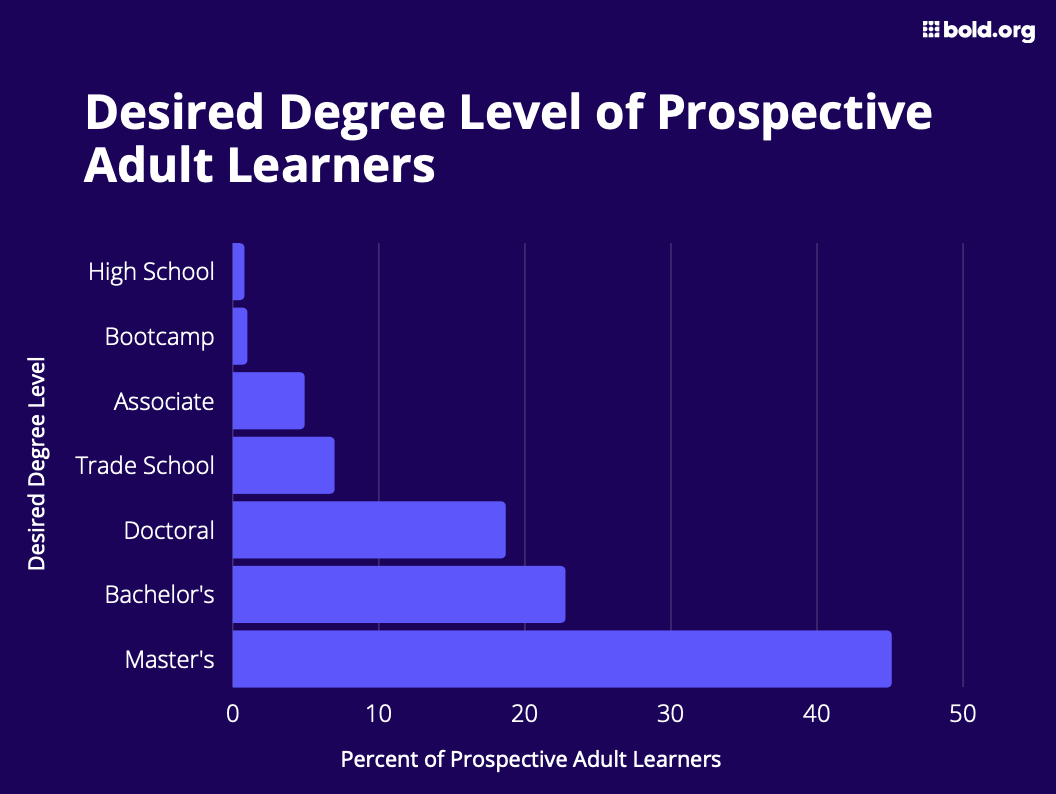Who Are Adult Learners, And What Do They Need?
Adult learners, students that are 25 years old or older, make up nearly 40% of enrolled students. Of the 19.7 million students enrolled in colleges and universities in 2020, 7.5 million were over the age of 25. However, apart from some notable exceptions, most schools are experiencing a decline in adult enrollment. So, who are adult learners, what trends are occurring within adult enrollment, and how can your school serve adult learners and fight the decrease in enrollment?
This whitepaper analyzes data from 14,300 prospective adult learners in combination with data from recent leading studies to guide your strategy to increase adult enrollment.
Recent trends - is adult enrollment shrinking?
As college becomes increasingly necessary to land a high-paying job in the United States, most adults have considered going to college to either complete a degree or to finish a degree they started previously. However, 70% of U.S. adults say they are unable to afford the costs of college. The often overwhelming costs of college, in combination with the other responsibilities that many adult learners have, such as caring for children, working, etc., deter many adults from enrolling.
Undergraduate enrollment of adults between the ages of 25 and 29 decreased by 4.3% in 2019 and by a further 5% in 2020. Similarly, undergraduate enrollment of adults 30 years old or older fell by 3.3% in 2019 and by 5.6% in 2020. As institutions increase their focus on adult learners, the rates of adult enrollment are shrinking. However, there is a small group of schools that have dominated adult undergraduate enrollment, notably Southern New Hampshire University and Western Governor’s University.
One possibility for bringing in new students is through online education. A group of 35 institutions in which 90% or more of their students are enrolled in online learning has experienced a 4.9% growth in undergraduate enrollment and a 9.7% growth in graduate enrollment among all students. However, graduate enrollment as a whole has only risen by 2.9%, showing that online-dominated schools are experiencing higher enrollment increases when compared to colleges as a whole.
Adult student enrollment has been declining for nearly a decade now at all different types of institutions, including private and public, four-year and two-year colleges. In 2019, 171,000 fewer adult students enrolled in college as compared to in 2018. This decrease can partially be explained by the strong economy during 2019 since adults are more likely to enter the workforce rather than school when the economy is good. The NCES expects enrollment for students over the age of 25 to increase by only 1% by 2027, while enrollment is expected to grow by 5% for students under the age of 25.
COVID-19: unlike other recessions?
The COVID-19 pandemic has further complicated adult enrollment. In the 2001 and 2008 recessions adult enrollment spiked, yet the economic crash from COVID-19 has produced different results. In the wake of COVID-19, surveys of adults in the U.S. have shown no increase in interest in education. Additionally, FAFSA applications fell by 9% in the first three months of 2020 for “independent” students, most of whom are over the age of 24.
The suddenness of the COVID-19 recession, uncertainty about the future of the pandemic, and health concerns are likely contributing factors to adults’ hesitancy to enroll.
Over 32 million people have completed some college but have not earned a degree, and the number of undergraduates who don’t complete their bachelor’s degree in six years has increased to around 40%.
However, as the pandemic continues and begins to come to a close, adult enrollment may spike once again. Around 60% of US adults have considered returning to college, so there is vast potential to increase adult enrollment in the coming years. In order to do so, institutions must understand who adult learners are, what goals they have, and what they need to be successful in school.
Who are adult learners?
Adult learners are a diverse group of students, and for the purpose of this analysis are considered to be current and prospective students who are at least 25 years old. Many adult learners have begun a degree in the past but haven’t finished, while others are turning to higher education for the first time.
Many adult learners face economic difficulty which can make education hard to afford, and most adult learners work and/or have children. All of these characteristics and responsibilities affect the enrollment of adult learners and result in adult learners having unique needs that must be met for them to access higher education.

The majority of adult learners, around 63%, work at least one job, and many work multiple jobs. Over half of adult learners are low-income, at 56%. The average income of adult students is $33,966, but adult learners fall into many different income brackets. 7.45% of adult learners have no income, and 8.55% make less than $10,000 per year.
The most popular income bracket is between $20,000 and $30,000, which nearly 19% of adult students fall under. The second most common income bracket is between $30,000 and $40,000 per year, with around 18% of adult learners, while almost 15% of adult students make more than $60,000 per year.
The wide variety of incomes of adult learners results in varying loan amounts amongst them. 50% of adult learners have student loans, either from current education or from previous time in college. For those who have loans, the average amount is $41,438.
An additional factor that affects adult enrollment is parental status. Nearly half of adult learners, around 46% have at least one dependent. Adult learners with dependents fall into four categories:
- Those with one dependent, making up nearly 16% of the data pool
- Those with two dependents, over 13% of all adult learners
- Those with three dependents, almost 9% of those surveyed
- Those with four or more dependents, nearly 8% of adult learners

Additionally, many adult learners are first-generation students, meaning their parents did not attend college. Nearly half of adult students, around 46%, are first-generation, and first-generation students of all ages make up around half of U.S. college students. First-generation students face unique challenges when it comes to enrolling in college and completing degrees.
Many adult students are first-generation because they did not complete a degree they previously began, since less than half of first-generation students are considered likely to graduate on time. Additionally, economic barriers prevent many first-generation students from attending college after high school, since continuing-generation students have a household income that is typically 165% higher than the household income of first-generation students.
Additionally, first-generation students are more likely to leave college before finishing a degree than students with at least one parent with higher education experience. Furthermore, many first-generation students face the struggle of a language barrier, since 20% of first-generation students don’t speak English as their first language.
Are you a first-generation adult learner? Apply to these first-generation scholarships today!
What are the goals of adult learners?
As previously mentioned, adult learners are a very diverse group. Therefore, adult learners strive for different careers, different roles, and different levels of education. The most common major of interest is nursing, with almost 15% majoring in some type of nursing major. Even within the group of adult learners interested in nursing, there is a wide variety of different specialties and fields desired.
- The most common majors within the category of nursing are registered nursing, adult health nursing, and family practice nursing.
- Other majors of interest include critical care nursing, trauma nursing, and maternal health nursing.
- The most common desired career field is medicine and health care, including dentistry, at almost 27%.
- As the nursing shortage grows in the United States, supporting students who are pursuing nursing is more important than ever.
One common major of interest, with 11% of adult learners interested, is business. Within the category of business, the most common specific majors are:
- Accounting and business
- Business administration and management
- Entrepreneurial operations.
- Other majors of interest include business communications, marketing, and international business.
The interest in majoring in business carries over to desired career roles, with company founder, CEO, company director, etc. being the most popular career roles of interest.
Additionally, over 8% of adult learners desire to go into the field of education or teaching. Among these adult learners, the most popular fields of interest include:
- Teaching
- Higher education, professorship
- Special education
- Early childhood education
Since adult learners have different levels of experience with higher education, they seek different levels of education. Adult learners predominantly seek degrees, especially a Bachelor’s or Master’s degree. The most common level of education sought is a Master’s degree, with 45% of students aiming for one.
Nearly 23% of adult learners seek a Bachelor’s degree, and almost 19% seek a doctoral degree. Fewer adult students seek other types of degrees and education, with nearly 7% interested in trade school, almost 5% aiming for an Associate’s degree, and a very small amount, less than 1% working towards high school education.

How can schools improve the enrollment of adult learners?
Outside responsibilities and financial limitations can discourage adults from enrolling in college, resulting in 38% of students leaving school after the first year.
Luckily, there are many ways to make higher education accessible to adults so that schools can bolster enrollment and provide opportunities to all students. One way to make college more feasible for parents, especially single mothers, is to offer childcare services on campus.
If you're a single mom, check out these single-parent scholarships for moms!
Over the course of eight years at Monroe Community College, providing affordable child care on campus was found to make parents 17% more likely to continue their education the next year, and made parents 26% more likely to graduate on time, though even with this increase only 41% of parents are likely to do so. However, by 2015 not even half of community colleges or public four-year schools had child care services on campus.
Additionally, due to parental obligations, working, or other responsibilities, many adult learners need increased flexibility to succeed in school. One form of flexibility is the “mini-mesters” that are now offered at several community colleges, such as Amarillo College. These shortened semesters are roughly half the length of a normal semester and have yielded a 30% increase in course completion at Amarillo College when compared to the standard semester. Mini-mesters can be taken in the summer as well, with no more than six credits taken at once, but still allow students to complete 30 credits a year.
Online courses also provide increased flexibility and accessibility. Since most online classes can be done at any time of day and any day of the week, students can fit school around other responsibilities, such as work or childcare. Flexible scheduling is critical for many students, and it has been found that the most common reason why adults between the ages of 25 and 64 stopped college before receiving a degree was because of difficulty balancing school with work.
Online learning is often more affordable too, either because of lower tuition or because it saves students transportation costs, childcare costs, on-campus housing costs, etc. Between 2016 and 2018, the number of students taking one or more online classes increased by 3.6% as 34.7% of students took at least one online class.
Throughout the COVID-19 pandemic, the amount of students taking online courses has rapidly increased. Almost two-thirds of colleges in the United States were fully or mostly virtual in fall 2021, causing difficulties for many low-income students without the equipment or privacy necessary to succeed in online classes. As the end of the pandemic draws near, the future of education is in question as the virtual classroom has become popularized.

Are community colleges a solution?
Despite the recent decrease in adult learners, there is still a potential for growth. Many adults view college favorably and would want to attend if finances weren’t a barrier.
- Roughly 70% of adults between 23 and 55 years of age who don’t have bachelor’s degrees think that it is important to have a bachelor’s degree in order to get a job.
- 70% also think that colleges succeed in preparing adults to enter the workforce.
- However, 70% also think that they are unable to attend college due to the costs.
- Additionally, 75% are worried about the student loans that often come with higher education.
To help encourage adults to enroll in higher education, affordable options, such as community college, are key. Over 40% of undergraduate students in the U.S. go to community colleges. Community colleges provide two-year programs at low costs, with average tuition and fees being $3,347 per year.
For adult learners, two-year degrees can be enough to expand career opportunities, or students can continue their education after attending community college by transferring to a four-year university and using the credits they earned affordably to reduce their time and costs at a four-year school. As potential transfer students, adult learners currently studying at community colleges can be a great pool for four-year universities to reach out to.
Organizational partnerships, a win-win situation?
An additional way to bolster adult enrollment is for schools to form organizational partnerships, such as with businesses, hospitals, etc. These partnerships help increase enrollment at partner colleges, add to name and brand recognition, and provide partner companies with qualified employees.
The U.S. spends around $772 billion annually on postsecondary education and training, but not even a third of the money goes to four-year schools, and only $40 billion goes to two-year colleges. Forming organizational partnerships, as some schools have done with companies such as McDonald’s, Starbucks, and even Fiat Chrysler, can benefit colleges and universities, students, and companies all at the same time.
Between organizational partnerships, offering online courses, and providing on-campus child care services, there are many opportunities for schools to expand adult enrollment by increasing the accessibility of their programs. Recognizing the unique needs that adult learners have due to factors such as being low-income, first-generation, parents, workers, etc., is essential in order to effectively advertise to adults and convince them to enroll.
As discussed above, most adults have thought about starting or returning to their journey in higher education, so the next step is to show adults what steps colleges are taking to ensure their success if they choose to enroll. By being flexible and affordable, colleges can significantly increase their enrollment of adult learners so that both schools and students can benefit.